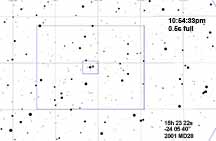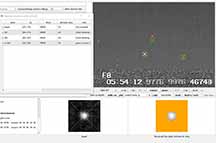

OW cloud map
This is a nominally good rank event, which runs very parellel and along Highland Way, making it hard to find accessible sites that are both good prospects for a 'positive' and also not right on top of Karl's home site, which is nicely close to the centerline. The altitude is 25 degrees, Az=157. It's bright enough to be pretty easy at 2x, but it is also only 17 degrees from the ~full moon, so it'll be a bright sky. Hopefully no fog, which would make the sky even brighter and harder to see through.
 |
 |
Karl and I both got solid positives. Karl also got a ~1/4s event clearly seen visually in play-back on his large screen TV at home this night. I've not reduced his yet formally. He was at home. He did it at 2x.
121d 59' 07.48"
37 08' 39.24"
1904 ft.
magDrop report: percentDrop: 67.1 magDrop: 1.207 +/- 0.476 (0.95 ci)
DNR: 2.04
D time: [05:54:31.8574]
D: 0.6800 containment intervals: {+/- 0.0243} seconds
D: 0.9500 containment intervals: {+/- 0.0932} seconds
D: 0.9973 containment intervals: {+/- 0.2494} seconds
R time: [05:54:32.4174]
R: 0.6800 containment intervals: {+/- 0.0243} seconds
R: 0.9500 containment intervals: {+/- 0.0932} seconds
R: 0.9973 containment intervals: {+/- 0.2494} seconds
Duration (R - D): 0.5600 seconds
Duration: 0.6800 containment intervals: {+/- 0.0420} seconds
Duration: 0.9500 containment intervals: {+/- 0.1352} seconds
Duration: 0.9973 containment intervals: {+/- 0.3058} seconds
I tried it from Mtn Charlie Monument just off Hwy 17. I was optimistic enough to go for it at 1x and analyze in field mode. That was a mistake; the S/N wasn't good enough to justify 1x, and I wish I'd done 2x. Still, I got a drop that came at the right time and passed the 5-sigma False Positive test. The duration was measured at 0.56s.
Below is the TME aperture analysis. It came out with tighter errors on the timings and better false positive test... It is the one I'll report to IOTA
 |
 |
 |
 |
 |
Below, I also tried a "dynamic aperture" analysis, applied to all stars used. Here's some results, not reported to IOTA. The resulting occultation duration was ~50% longer than the max predicted, a too long at 0.78s and timing accuracies significantly worse. Don't know why. This analysis is not favored and will not be reported to IOTA.
 |
The errors on the D and R are worse here. |
The event solved barely passes the 5-sigma test. |
Got a recording from home at 2x setting. I watched the raw video tape channeled to his big screen TV. The star was quite easy to follow on every frame and showed a definite 1/4s complete disappearance bit early of the predicted event time, in good agreement with my own data. I will have to reduce this tape; not done yet. I will report the results to IOTA.